OpenStack Mitaka Horiozn 主题开发
Posted Mr_扛扛
tags:
篇首语:本文由小常识网(cha138.com)小编为大家整理,主要介绍了OpenStack Mitaka Horiozn 主题开发相关的知识,希望对你有一定的参考价值。
一、写在前面
这篇文章主要介绍了OpenStack Mitaka Horizon主题的开发。这里只是说明horiozn主题包的开发逻辑,不具体阐述css、js、html文件的开发, 仅仅是说明horizon主题开发的方式,因为时间仓促以及个人理解有限,固有错误的地方请指出,后续将会不定期的完善,谢谢!
如果转载,请保留作者信息。
邮箱地址:jpzhang.ht@gmail.com
主题下载地址:https://jianpengzhang.github.io/2017/02/26/2017022602/
二、环境准备
注意:如果没有特殊说明,一下所有命令均是在root用户下执行。
通过devstack 部署OpenStack Mitaka单节点基础版本(nova、keystone、glance、vloume、horizon),具体如何部署可以参考我的另一片博文,部署完成之后可以看到目录结构如下:
.
├── cinder
├── glance
├── horizon
├── keystone
├── logs
├── neutron
├── nova
├── noVNC
├── requirements
└── tempest
可以看到我这里安装的所有组件的源码包,根据实际情况会有不同,以自己的的为主。
这里主要介绍horizon组件theme的开发,其他组件这里不涉及,不需要关注,只要保证各个服务时运行正常即OK,后续将逐渐来说明其他的组件的开发,大家可以关注下我的博客或者最近刚建的博客,后续将同步更新,废话不多说,进入正题。
拷贝一份horizon代码包:
cp -r horizon horizon.dev进入:cd horizon.dev
通过django 自带的测试服务,运行horizon组件
python manage.py runserver 0.0.0.0:8001
输出:
Performing system checks...
System check identified no issues (0 silenced).
June 12, 2016 - 13:21:59
Django version 1.8.10, using settings 'openstack_dashboard.settings'
Starting development server at http://0.0.0.0:8001/
Quit the server with CONTROL-C.如果是通过devstack部署的,通过这种方式运行起来的horizon,通过浏览器访问,浏览器将会出现如下错误:
Page not found (404)
Request Method: GET
Request URL: http://192.168.31.235:8001/dashboard/auth/login/?next=/
Using the URLconf defined in openstack_dashboard.urls, Django tried these URL patterns, in this order:
^$ [name='splash']
^api/
^home/$ [name='user_home']
^i18n/js/(?P<packages>\\S+?)/$ [name='jsi18n']
^i18n/setlang/$ [name='set_language']
^i18n/
^jasmine-legacy/$ [name='jasmine_tests']
^jasmine/.*?$
^identity/
^developer/
^admin/
^settings/
^project/
^auth/
^dashboard\\/static\\/(?P<path>.*)$
^dashboard\\/media\\/(?P<path>.*)$
^500/$
The current URL, dashboard/auth/login/, didn't match any of these.
You're seeing this error because you have DEBUG = True in your Django settings file. Change that to False, and Django will display a standard 404 page.你可以看到浏览器url地址栏默认跳转到了:
“http://192.168.31.235:8001/dashboard/auth/login/?next=/“
如果我们手动把浏览器地址栏中的/dashoboard/去除再次刷新就可以看到熟悉的horizon默认的登录界面
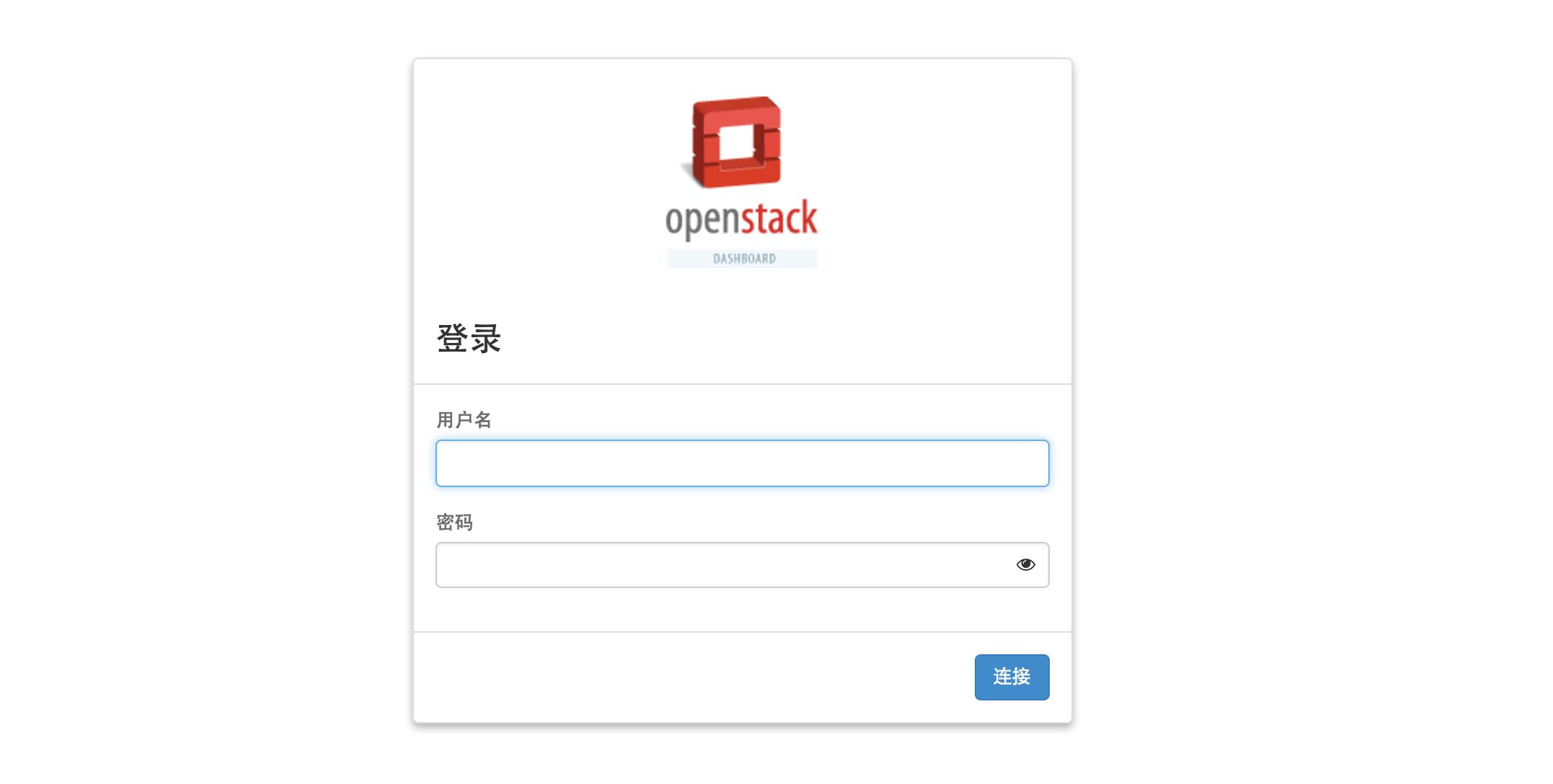
不用担心,这是因为horizon的配置文件配置的url里面默认根目录是从“dashboard”开始的,如果通过apache运行,就可以在apache horizon的配置中看到,默认horiozn的资源访问路径是从‘dashboard’开始,apache如下:
WSGIScriptAlias /dashboard /home/devstack.mitaka/horizon/openstack_dashboard/wsgi/django.wsgi
WSGIDaemonProcess horizon user=stack group=stack processes=3 threads=10 home=/home/devstack.mitaka/horizon display-name=%{GROUP}
WSGIApplicationGroup %{GLOBAL}
SetEnv APACHE_RUN_USER stack
SetEnv APACHE_RUN_GROUP stack
WSGIProcessGroup horizon
DocumentRoot /home/devstack.mitaka/horizon/.blackhole/
Alias /dashboard/media /home/devstack.mitaka/horizon/openstack_dashboard/static
Alias /dashboard/static /home/devstack.mitaka/horizon/static
RedirectMatch "^/$" "/dashboard/"
那这里我们只要修改horizon的配置,让其默认的访问路径从“/”开始即可正常。
具体修改:
vi horizon.dev/openstack_dashboard/local/local_settings.py
找到:WEBROOT="/dashboard/"
修改为:WEBROOT="/"
cd horizon.dev/
运行(静态文件压缩):python manage.py compress
输出:
Found 'compress' tags in:
/home/devstack.mitaka/horizon.dev/openstack_dashboard/templates/horizon/_conf.html
/home/devstack.mitaka/horizon.dev/openstack_dashboard/templates/_stylesheets.html
/home/devstack.mitaka/horizon.dev/openstack_dashboard/templates/horizon/_scripts.html
Compressing... done
Compressed 5 block(s) from 3 template(s) for 2 context(s).重启服务:python manage.py runserver 0.0.0.0:8001
再次访问浏览器地址:http://192.168.31.235:8001/
这回自动跳转到:http://192.168.31.235:8001/auth/login/?next=/
地址栏中没有出现“/dashboard/” 并且正常出现horizon登录界面,至此我们的开发环境准备完成,至于用什么IDE来开发,我相信每个程序员都有自己的喜好,这里我使用Sublime来开发,个人比较偏向于pycharm来开发,无奈环境安装在虚拟机中,pycharm社区版不支持远程开发,正好sublime有sftp工具能够远程通过代码进行开发,一拍即合,这里就用sublime来进行开发工作。
三、目录结构
Horizon目录结构介绍,之前有一篇博文进行了专门的介绍,不了解的可以翻一翻,这里主要介绍下几个主题开发会用到的目录以及自己创建的主题包:
.
├── doc
├── horizon
├── horizon.egg-info
├── openstack_dashboard
├── releasenotes
├── static
└── tools
可以看到horizon最外层有一个static静态文件目录,这个静态目录是用来干什么的呢?进入目录可以看到它的结构如下:
.
├── app
├── auth
├── bootstrap
├── dashboard
├── framework
├── horizon
├── scss
└── themes
这个目录其实就是horizon界面访问的静态文件的统一入口,所有样式模版(css、js、html)都是这个目录提供的,那是不是我们开发的静态文件放在这个目录中呢,其实不然,我这个目录的文件是通过一个命名生成的,
命令:python manage.py collectstatic
一般我会在后面加一个 “-c” 的参数,把原先 static目录中的内容清空。
大家可以通过python manage.py collectstatic -h 具体查看这个命令的功能,简单来说会把horizon目录下以及dashboard目录下所有用到的静态文件统一拷贝到这个目录中,在通过命令进行压缩,为上层提供所有的样式文件。
命令:python manage.py compress
horizon.dev/horizon目录,这个目录用来定义horizon组件全局的样式文件,其中包括一个static、 templates、templatetags 目录,
static:存放一些静态文件CSS、 JS
templates:存放模版文件主要是html页面
templatetags:定义html模版页面中出现出现的标签例如:在horizon.dev/horizon/templates/horizon/_nav_list.html {% if user|has_permissions:component %},horizon.dev/horizon/templatetags/horizon.py中就有定义。horizon.dev/openstack_dashboard目录,同样在这个目录下也包括static、 templates、templatetags 目录,作用和上述的一样,不过这里定义的不是全局的,可以把它当作是对horizon目录中定义的文件,在这里在做差距化的定义。
那么horion加载的同一个文件在两个地方都有的情况下回调用哪个文件,这个你可以看下django 模版调用机制,horiozn组件很好的利用了这一点,这里我也记不太清了,记忆中是先调用openstck目录中的,找不到的情况下会去horizon里面去找。
好了,具体不再细聊了,接下去就开始我们定制化的开发工作。
四、bruce主题初始化
进入我们的主题开发目录,通过拷贝现有的material目录结构来具体说明:
cd horizon.dev/openstack_dashboard/themes该目录用来存放horizon组件的所有的主题包,默认已经有两个目录包default、material 在上个版本中,已经支持主题开发,甚至在juno版本中也支持了,只是在Mitaka更加完善了这部分,如果学会了在Mitaka版本的开发原理,在juno版本中开发也是如此。
默认horizon采用的是default 目录,但是可以通过dashboard界面的切换主题的按钮进行主题切换如下:

拷贝一份“Material”目录为bruce目录
cp -r material/ bruce如果仅仅拷贝一份还是不行的,要让horizon识别,还需要在配置文件中进行配置,
这里我为了方便直接修改了settings.py(你也可以修改local/local_settings.py):
vi horizon.dev/openstack_dashboard/settings.pyAVAILABLE_THEMES = [
(
'default',
pgettext_lazy('Default style theme', 'Default'),
'themes/default'
), (
'material',
pgettext_lazy("Google's Material Design style theme", "Material"),
'themes/material'
),
(
'bruce',
pgettext_lazy("Google's Material Design style theme", "Bruce"),
'themes/bruce'
),
]这个时候你刷新浏览器会提示错误,需要你运行“python manage.py compress”,重新编译压缩下,那就按照提示做,运行命令:
python manage.py compress
重启: python manage.py runserver 0.0.0.0:8001再次刷新浏览器,你就可以看到刚刚我们定义的主题bruce:
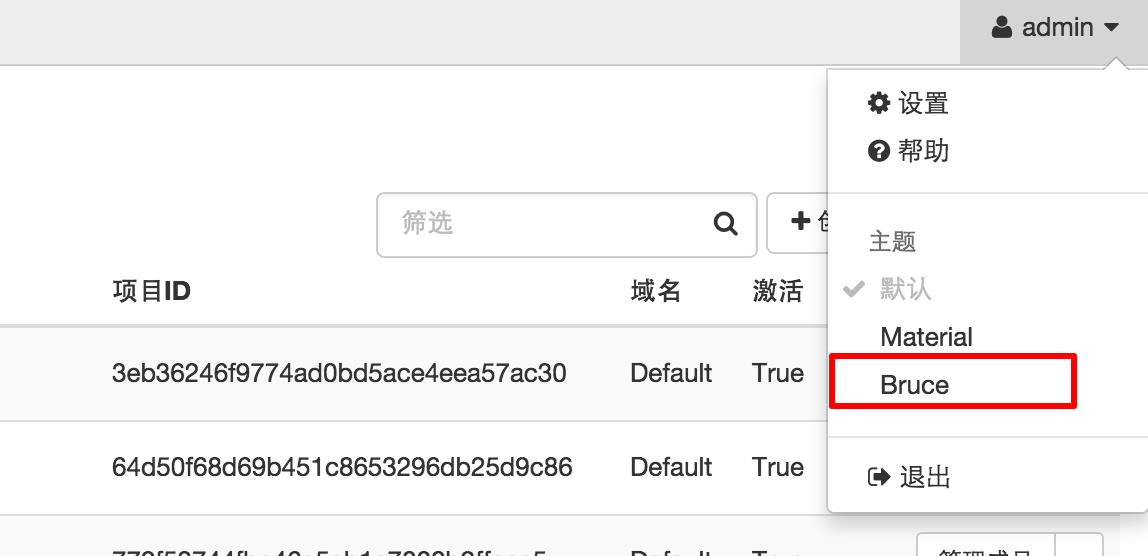
切换至Bruce主题可以看到和Material一样的样式主题
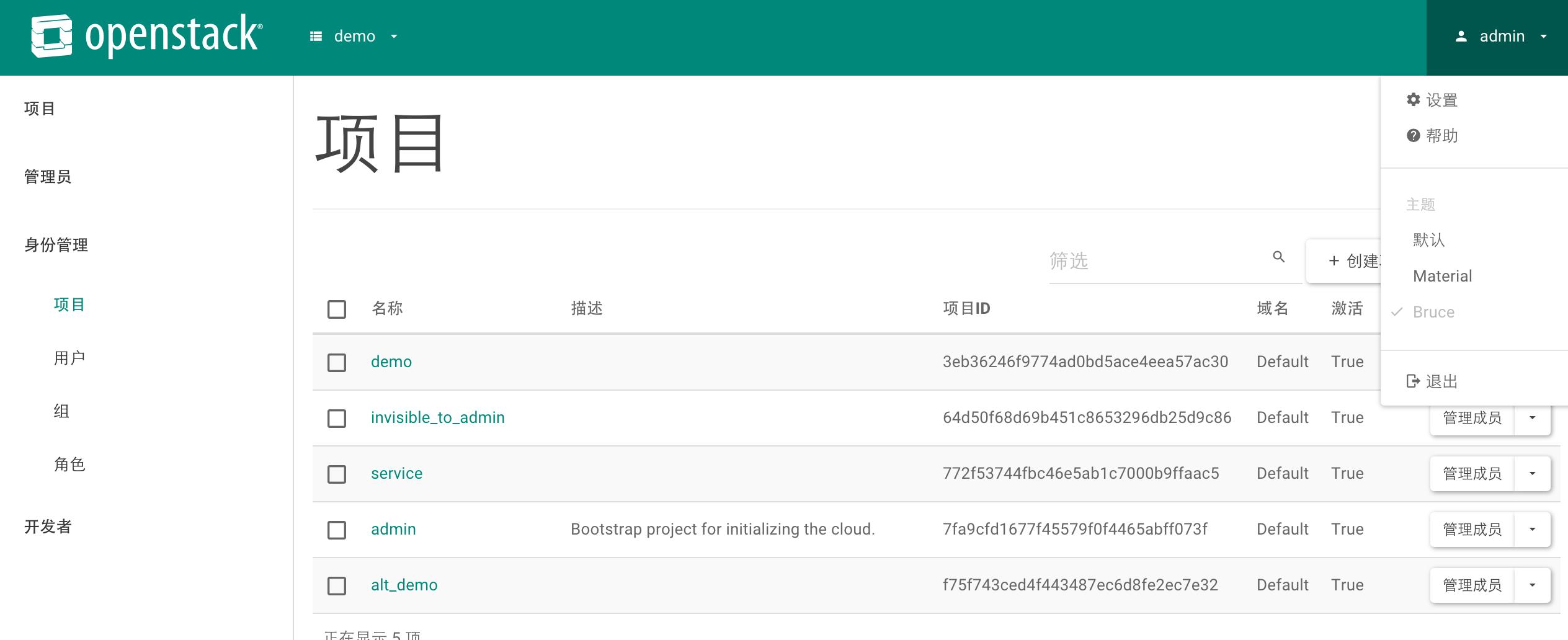
Bruce从Material拷贝过来当然一样。
那么如何让我们的Bruce主题成为horizon主题默认主题呢,还是一样,修改
vi horizon.dev/openstack_dashboard/settings.pyDEFAULT_THEME = 'default' => DEFAULT_THEME = 'bruce'
这个时候你清空浏览器缓存,重新登录horiozn,你就会发现horizon默认的主题采用的不是“default”而是我们定义的“bruce”。
接下来我们来具体认识下从Material拷贝过来的目录包括了哪些东西,具体有什么用。
.
├── static
│ ├── bootstrap
│ ├── horizon
│ └── js
│ └── _styles.scss
│ └── _variables.scss
│
└── templates
├── auth
├── header
├── horizon
└── material
static(静态文件):
bootstrap:引入bootstrap目录,具体可以看看bootstrap目录中的_styles.scss、_variables.scss
- horizon:引入horizon组件的静态文件包
- js:引入自定义的js文件
- _styles.scss:引入bootstrap、horizon目录中的样式文件,通过“@import “bootstrap/styles”;”其中styles指的是bootstrap目录中_styles.scss文件,同理horizon。
- _variables.scss:引入bootstrap、horizon目录中的定义的scss定义的变量文件,通过“@import “bootstrap/variables”;”其中variables指的是bootstrap目录中_variables.scss文件,同理horizon。
templates html模版文件:
其实修改horizon的模版文件很简单,我只要按照上文中提到的horizon模版定义的路径,在自己的主题模版中再定义一遍就能覆盖,其实也不叫覆盖,就是在我的主题模版中一模一样的路径以及文件名定义一份,那么优先加载我定义的,当然前提是主题需要切换到我定义的主题上,不然还是不会加载的。
以下目录的介绍不单单指的是当前主题中定义的,还包括horizon主题模版中这些目录包含的内容,如果我对这些模版有修改的需求,我只需要在这里定义一遍,切换到我定义的主题时,就能应用上。
auth:horizon登录界面相关的模版文件
header:horizon内页header样式文件,包括项目切换等。
horizon:这个目录包括的东西比较多,包括内页左侧导航、form表单、table、model、tab等
material:这里我不需要了,直接删除就可以了
梳理了一遍,现在把bruce主题目录下面不需要的目录删除,添加自己需要的目录,具体目录结构如下:
为了方便开发,我这里直接把auth、templates、horizon拷贝到bruce templates目录中,按照正常的开发来说,我需要重定制什么那么就把什么文件在主题中定义一遍,我这边为了方便直接把整个目录拷贝过来了。
cp -r /horizon.dev/horizon/templates/auth/
cp -r /horizon.dev/openstack_dashboard/templates/header/
cp -r /horizon.dev/horizon/templates/horizon/并且在static目录中新建了一个bruce目录用来放我的静态文件。在最外层_styles.scss、_variables.scss文件中引入bruce目录中styles、variables定义的内容。引入方式很简单,分别在最外层_styles.scss、_variables.scss文件增加以下内容:
_styles.scss:
@import "bruce/styles";
_variables.scss:
@import "bruce/variables";在运行命令:
这里不再细说scss样式文件的开发,后续有时间在通过其他博文具体来说明。
python manage.py collectstatic -c
python manage.py compress把你新增的scss文件编译压缩。
最终你的目录结构看起来会是这个样子:
.
├── static
│ ├── bootstrap
│ ├── bruce
│ ├── _styles.scss
│ └── _variables.scss
│ ├── horizon
│ ├── _styles.scss
│ └── _variables.scss
└── templates
├── auth
├── header
└── horizon
其中,在templates/horizon目录下面,我从
openstack_dashboard/templates/horizon/_scripts.html文件拷贝了一份,现在你可以把你的js文件放在static/bruce/js目录中,通过_scripts.html文件加载进来,不过,通过这个文件加载的js文件时全局的,即各个页面只要按照horizon的html结构就能全部应用到,如果不想在各个页面使用,可以单独在html页面中引用,css文件也可以通过在html页面中单独引用,具体怎么引你可以看下_scripts.html引用方式即可。
五、登录界面开发
之前提过,horizon登录界面的模版文件全部定义在auth目录中,现在我们简单进行开发,
打开:/themes/bruce/templates/auth/login.html 登录界面的入口文件
{% extends "base.html" %}
{% load i18n %}
{% block title %}{% trans "Login" %}{% endblock %}
{% block body_id %}splash{% endblock %}
{% block content %}
{% include 'auth/_login.html' %}
{% endblock %}
{% block footer %}
{% include '_login_footer.html' %}
{% endblock %}
可以看到,这个文件继承自base.html,定义在
horizon.dev/openstack_dashboard/templates目录中,
base.html:文件定义了整个html的目录结构,如果你需要调整html结构,可以把这个文件复制到/themes/bruce/templates/目录中,如果登录界面的html结构和内页的结构不一样,可以重定义一个login_base.html,只要{% extends “login_base.html” %}即可。
这里同样我把这个文件复制了过来。为了说明,草率的进行了修改
修改加了一个div:
<body id="{% block body_id %}{% endblock %}" ng-app='horizon.app' ng-strict-di>
<div style="background-color: #DE1426;">
Test
</div>
......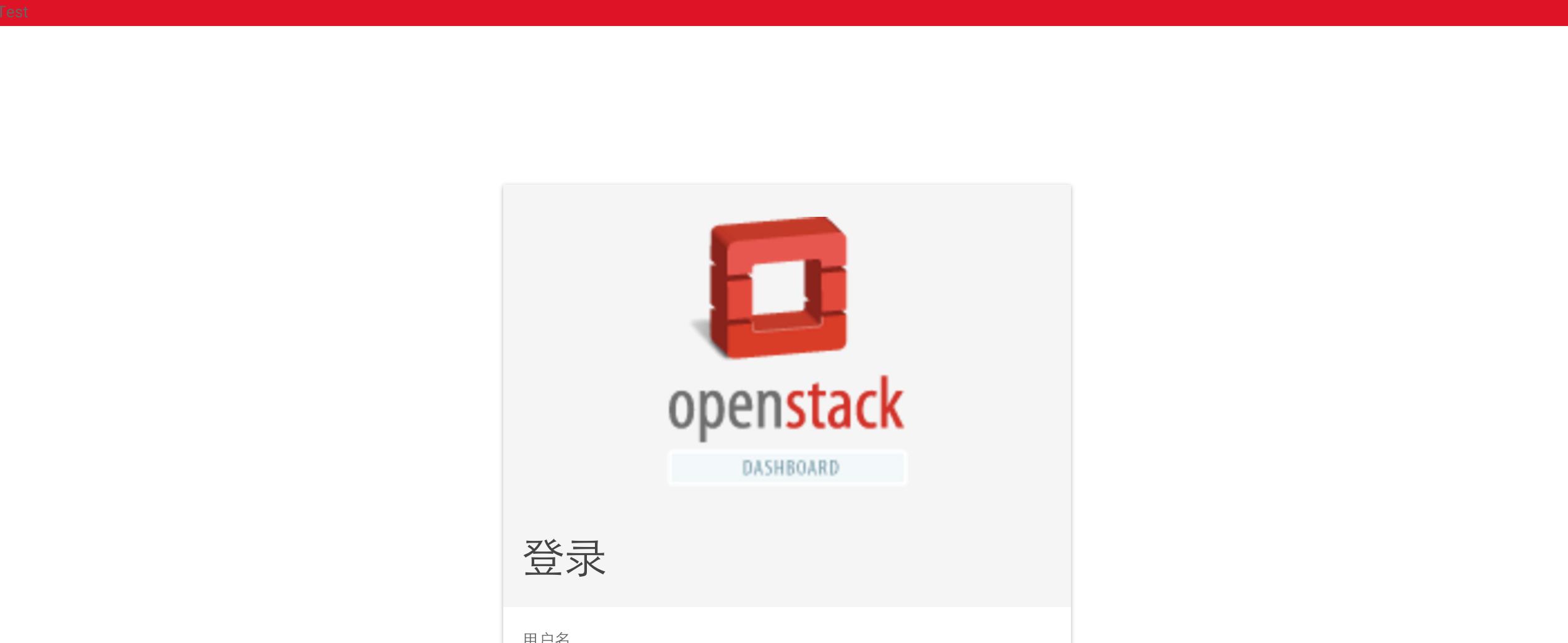
可以看到生效了,看起来比较丑,哈哈,说明我们的结构修改生效了。
接下来我们再来看下auth/_login.html,
{% load i18n %}
{% if 'is_modal' in request.GET or 'is_modal' in request.POST %}
{% include 'auth/_login_modal.html' %}
{% else %}
{% include 'auth/_login_page.html' %}
{% endif %}这个文件引入了_login_modal.html文件和_login_page.html文件,如果你觉的这样的引入层级太复杂了,也可以直接修改掉。
auth/_login_modal.html:定义登录表单,打开这个文件,可以看到它时继承自auth/_login_form.html文件,这个文件中详细定义了登录界面,
修改如下:
<div class="panel-heading">
{% block login_header %}
<h3 class="login-title">
{% trans 'Log in' %}Hello World
</h3>
{% endblock %}
</div>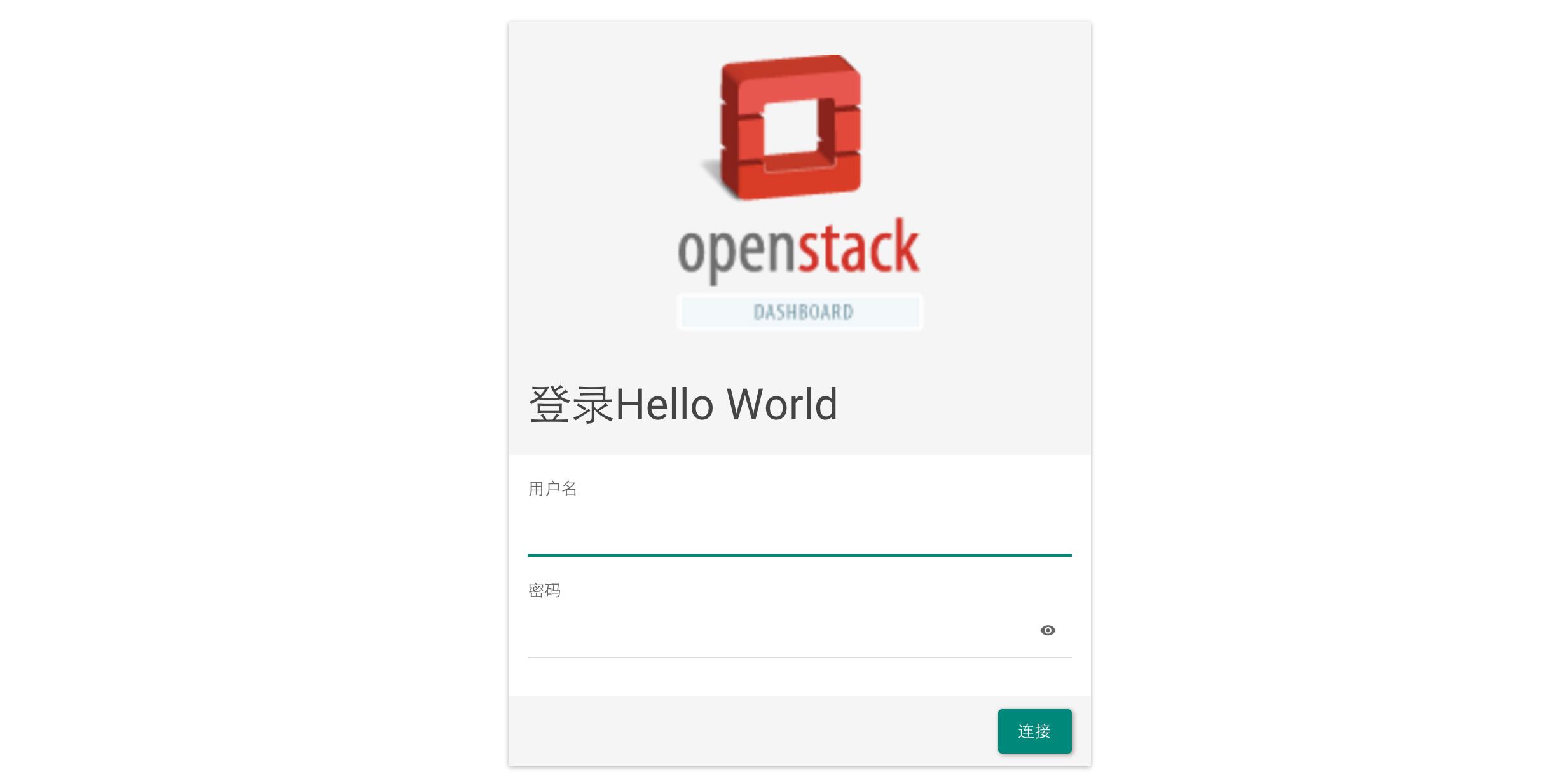
简单吧,登录界面的修改就是这些auth/*.html页面中,具体就要看你需要修改成什么样子。
五、header 修改
好了,现在我们来看下登录进去之后header这块怎么来修改,
同理:header html页面主要在/themes/bruce/templates/header目录中
通过base.html:
<div class='topbar'>
{% include "header/_header.html" %}
</div>可以得知_header.html是header模块的入口文件,打开
/themes/bruce/templates/header/_header.html
修改如下:
<nav class="navbar navbar-default navbar-fixed-top" style="background-color: #3E3B3B;">
....效果如下:
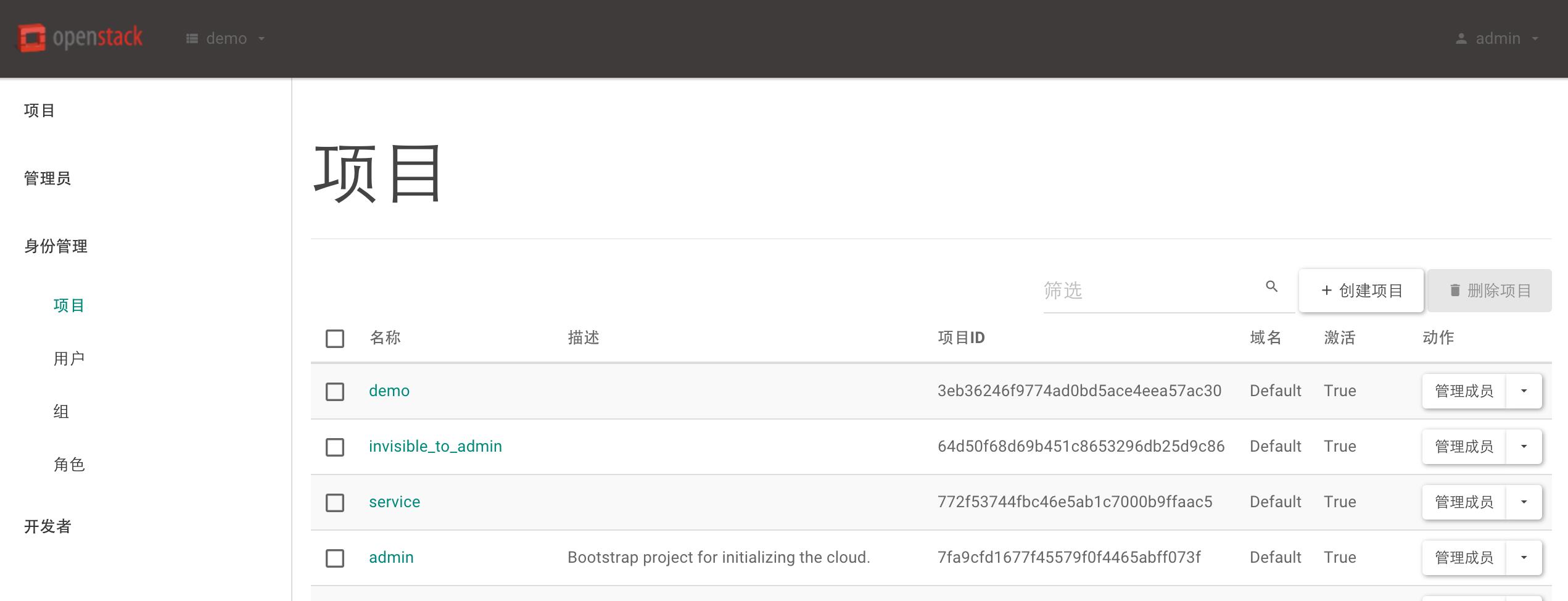
继续往下看,可以看到_header.html文件中引入
{% include “header/_brand.html” %}:
没什么好讲,这个文件主要用来加载logo,如果你对logo的部署有所调整可以在这个文件中修改。{% include “header/_context_selection.html” %}:
该文件主要用来在定义项目/区域切换的样式:
简单修改如下:{% else %} <li class="dropdown" style="background-color: #57b382;"> ......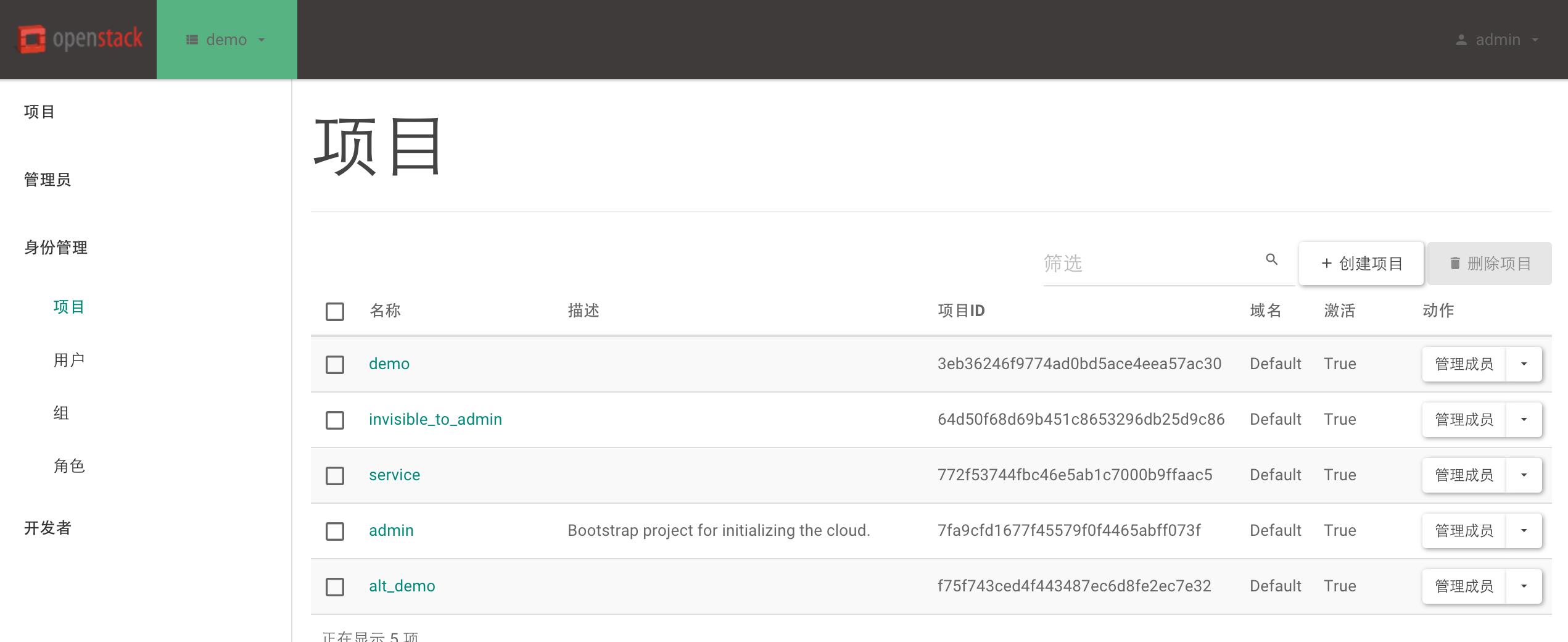
可以看到项目切换颜色发生了变化。
在这个文件中通过{% load context_selection %}自定义的标签引入了horizon.dev/openstack_dashboard/templatetags/context_selection.py 整个horizon项目中templatetags目录中定义的私有的django模版标签即自定义模版标签。
通过引入这个文件,在_context_selection.html中使用的标签都可以在context_selection.py文件中找到他的实现。
{% show_overview %}:对应“def show_overview(context)”方法,并且可以根据这个方法得知它所使用的模版horizon.dev/openstack_dashboard/templates/context_selection/_overview.html,如果你想修改这个模版片段,原理都一样,那这个文件安相同的目录结构在我们的主题/themes/bruce/templates/context_selection/建立起来再进行修改即可,这里不再详细说明。
{% show_domain_list %}:修改原理同上
{% show_project_list %}:修改原理同上
{% show_region_list %}:修改原理同上
{% include “header/_user_menu.html” %}:
主要用来显示右侧点击当前登录用户名的下拉列表框,包括帮助、主题切换、退出等功能
简单修改如下:{% else %} <li class="dropdown user-menu" style="background-color: #57b382;">效果:

{% include “header/_region_selection.html” %}:
用来定义区域选择,因为本地开发环境没有多区域,不能简单修改样式,但基本和上述一样进行修改即可。
如果你想在header下面添加面包屑,这一块horizon默认已经给我写好了一个样式,通过下面的修改很快就能实现一个简单样式的面包屑,当然样式就不咋的了,
修改:/themes/bruce/templates/header/_header.html
......
<div style=" margin-top: 43px; margin-left: 240px;">
{% include 'horizon/common/_breadcrumb_nav.html' %}
</div>
{% endspaceless %}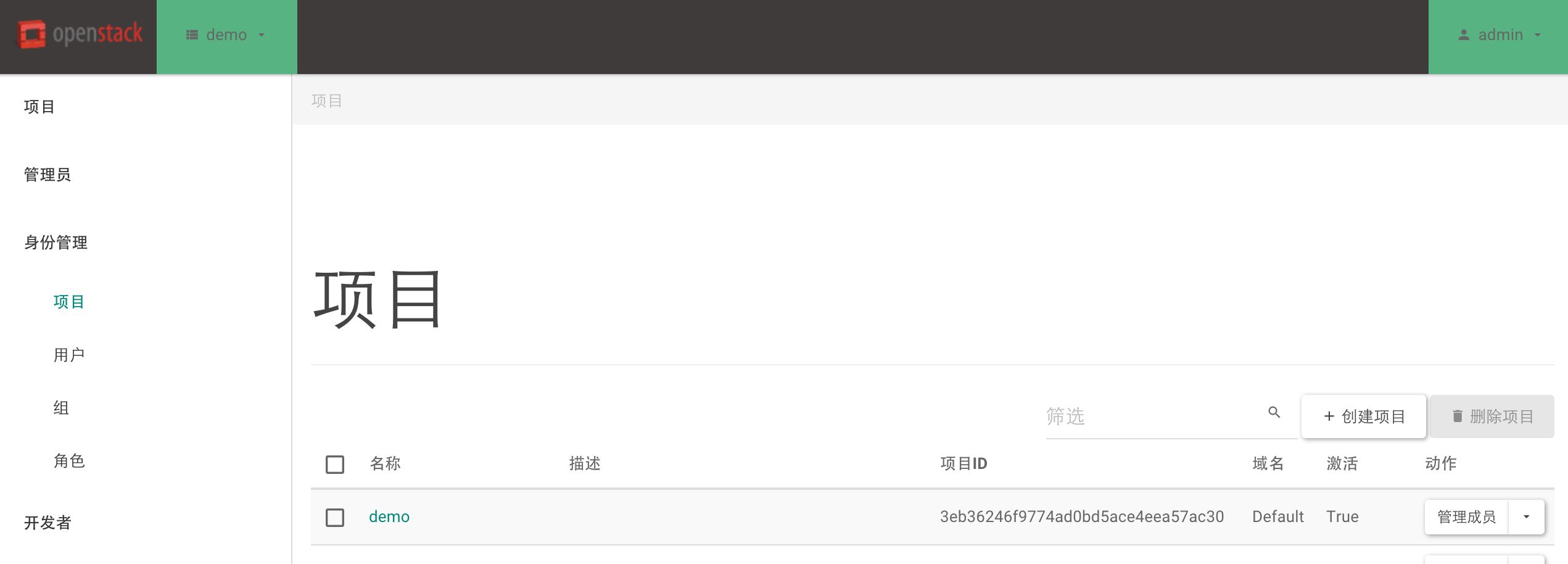
header的开发就讲到这里,其实都还比较简单。
五、sidebar修改(侧边导航)
根据/themes/bruce/templates/base.html 可知侧边导航入口文件为:{% include ‘horizon/common/_sidebar.html’ %}
......
{% block sidebar %}
{% include 'horizon/common/_sidebar.html' %}
{% endblock %}
......ok,我们打开/themes/bruce/templates/horizon/common/_sidebar.html
{% load branding horizon i18n %}
<div id='sidebar' style="background: #353644;">
{% horizon_nav %}
</div>那么在哪里定义了horizon_nav这个变量呢?可以看到它加载了{% load branding horizon i18n %},注意,这里有“horizon”这个文件指的是horizon.dev/horizon/templatetags/horizon.py,其中{% horizon_nav %}标签通过文件中的”def horizon_nav(context):“函数方法定义,并且该函数方法指定了模版文件为horizon/_sidebar.html。如果需要对返回的数据格式有修改就需要改动这个文件,不建议直接修改,可以重构一个方法来进行修改合适。打开/themes/bruce/templates/horizon/_sidebar.html,没什么好讲都是html代码,其中导航就是通过for标签循环components变量加载出来的,直接进行修改就行了。
简单的在:
/themes/bruce/templates/horizon/common/_sidebar.html
{% load branding horizon i18n %}
<div id='sidebar' style="background: #43444C;">
{% horizon_nav %}
</div>
/themes/bruce/templates/horizon/_sidebar.html
在不同的<li>以及<a>便签添加了
style="color: #fff"
style="background: #353644;"效果如下:
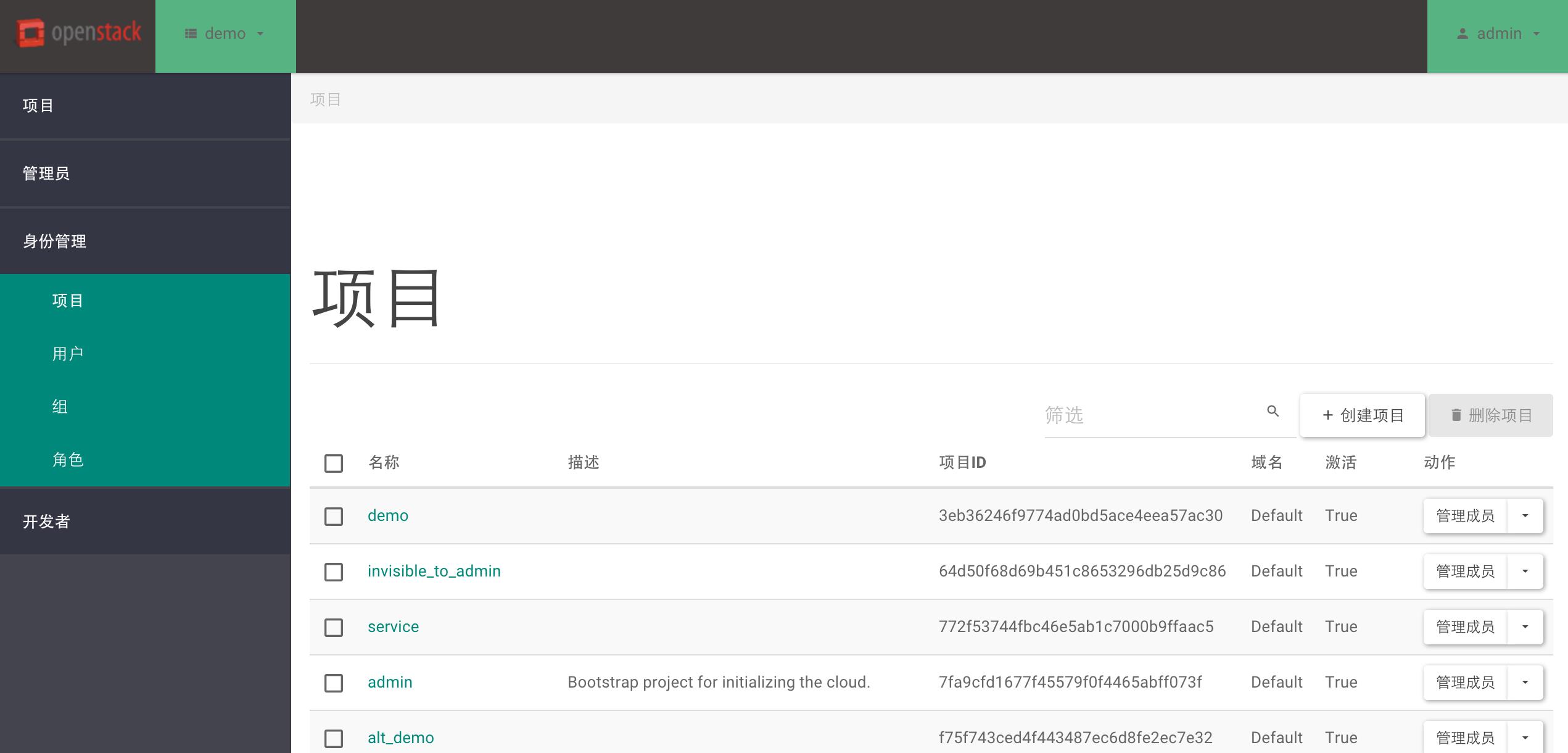
六、page header 修改
/themes/bruce/templates/base.html文件中包括了html
horizon/common/_page_header.html:
.....
{% block page_header %}
{% include "horizon/common/_page_header.html" with title=page_title %}
{% endblock %}
......这个文件主要用来定义右侧页面用来显示当前plan名字位置区域,开打该文件:
/themes/bruce/templates/horizon/common/_page_header.html
{% load i18n %}
{% block page_header %}
<div class='page-header'>
{% if actions %}
<form class='actions_column pull-right' action='{{ url }}' method="POST">
{% csrf_token %}
{{ actions }}
</form>
{% endif %}
</div>
{% endblock %}修改为:
{% load i18n %}
{% block page_header %}
<div class='page-header'>
<div class="alert" style="background-color:#bce8f1;border-color: #bce8f1;color: #31708f;" role="alert">
BruceCloud 为您提供一种随时获取的、弹性的计算能力,这种计算能力的体现就是 <em>主机(Instance)</em>。主机就是一台配置好了的服务器,它有您期望的硬件配置、操作系统和网络配置。通常情况下,您的请求可以在10秒到60秒的时间之内 完成,所以您完全可以动态地、按需使用计算能力。
</div>
{% if actions %}
<form class='actions_column pull-right' action='{{ url }}' method="POST">
{% csrf_token %}
{{ actions }}
</form>
{% endif %}
</div>
{% endblock %}效果:
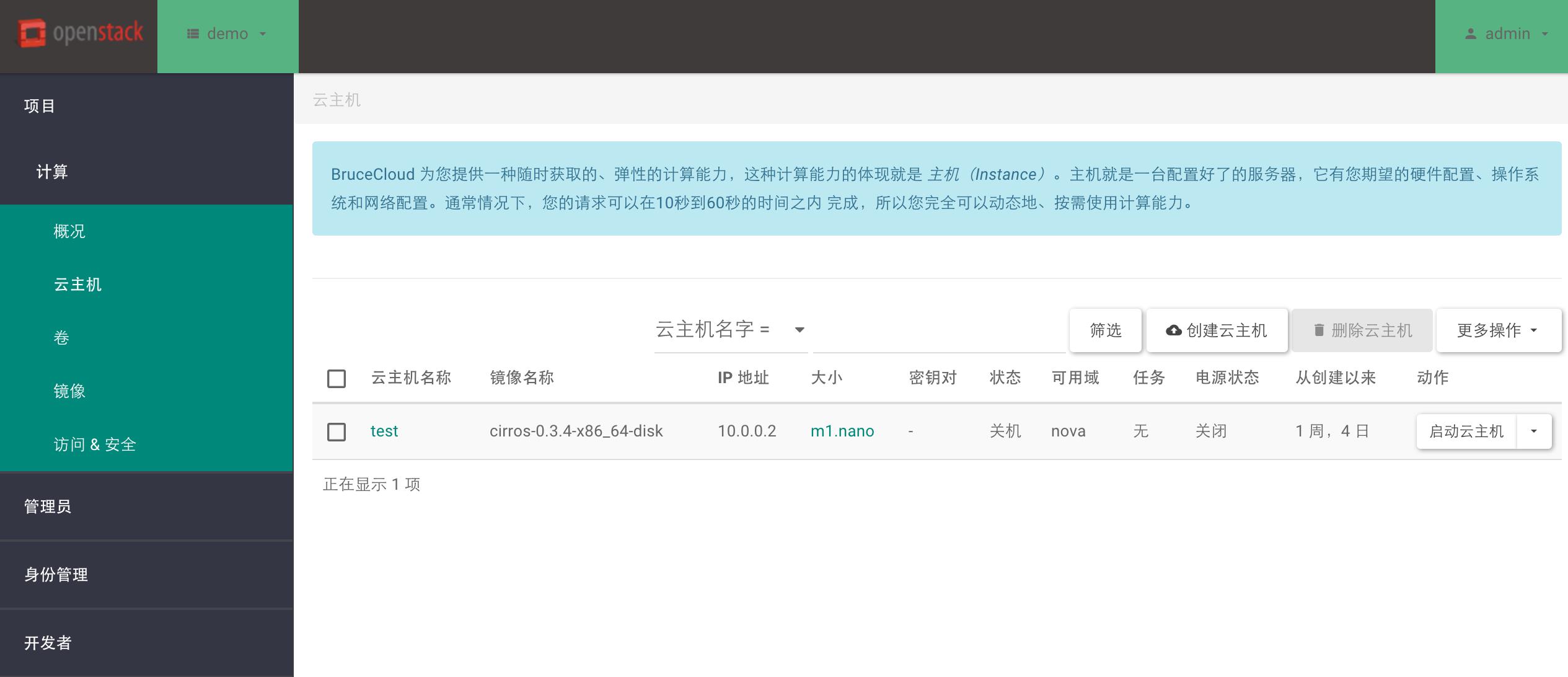
六、footer 修改
/themes/bruce/templates/base.html文件中包括了html
_footer.html :
{% block footer %}
{% include "_footer.html" %}
{% endblock %}该文件默认放在horizon.dev/openstack_dashboard/templates/_footer.html目录下,老方法,拷贝一份到/themes/bruce/templates/目录下,打开:
{% comment %}
A simple placeholder template for custom global footer content
{% endcomment %}默认控制为不显示出来,不细究,反正比较简单。
六、messages 修改
/themes/bruce/templates/base.html文件中包括了html
horizon/_messages.html:
......
<div id='main_content' style="margin-top: -90px;">
{% include "horizon/_messages.html" %}
......打开:/themes/bruce/templates/horizon/_messages.html:
{% for message in messages %}
{% if "info" in message.tags %}
<div class="alert alert-info alert-dismissable fade in">
<a class="close" data-dismiss="alert" href="#">
<span class="fa fa-times"></span>
</a>
<p><strong>{% trans "Info: " %}</strong>{{ message }}</p>
</div>
{% endif %}
......文件中定义不同消息类型显示的样式。需要修改的直接改这个文件就可以了。
七、project/instances修改
原理很简单,在每个模块下面都有一个templates,当然不直接修改这个目录下面的模版文件,我们把整个模版目录拷贝到我们的主题模版目录下面来进行修改,例如:
建立如下目录结构:
horizon.dev/openstack_dashboard/themes/bruce/templates/project
拷贝:
cp -r ../../../../dashboards/project/instances/templates/instances/ ./
好了,现在我们开始修改我们主机模版目录下面的instances模版样式文件:
修改云主机下拉列表页面,打开目录:themes/bruce/templates/project/instances/index.html
{% extends 'base.html' %}
{% load i18n %}
{% block title %}{% trans "Instances" %}{% endblock %}
{% block main %}
<div class="jumbotron">
<h1>Hello, world!</h1>
<p>...</p>
<p><a class="btn btn-primary btn-lg" href="#" role="button">Learn more</a></p>
</div>
{{ table.render }}
{% endblock %}
效果:
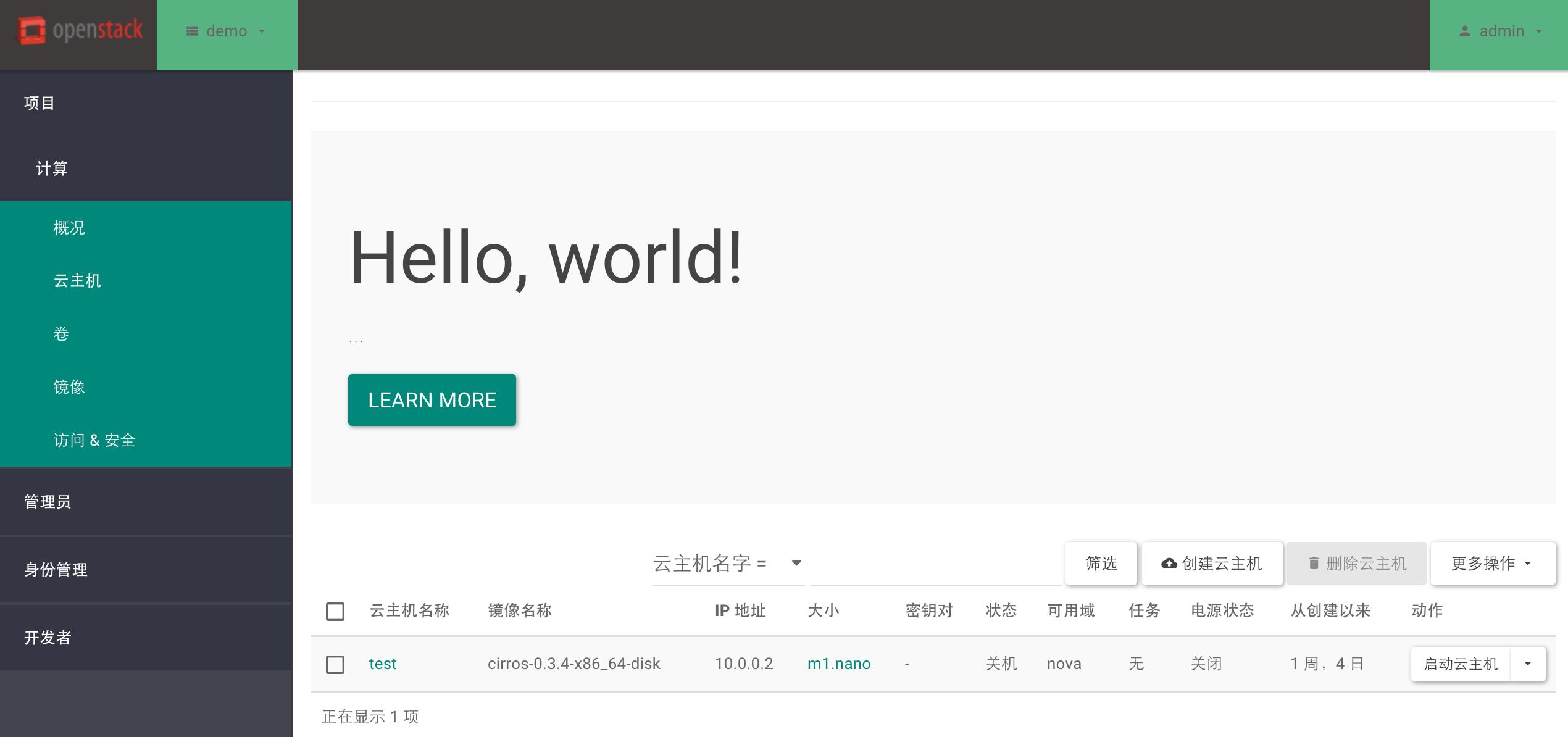
修改table样式:
类似table、modal、form样式的定义不在instances这个目录下面,这个目录下定义的都是instances所特有的样式结构;table、modal、form这些样式的定义往往是全局的,基本都是放在themes/bruce/templates/horizon/common目录下面,
例如:
themes/bruce/templates/horizon/common/_data_xxx.html用来定义table的样式;
themes/bruce/templates/horizon/common/_form_xxx.html定义form表单;
themes/bruce/templates/horizon/common/_modal_xxx.html定义modal表单;定义弹出框;
……
其他模块的修改都是类似的,例如概况页面、云硬盘等,拷贝到我们的主题目录下面进行修改。

主题切换回default:
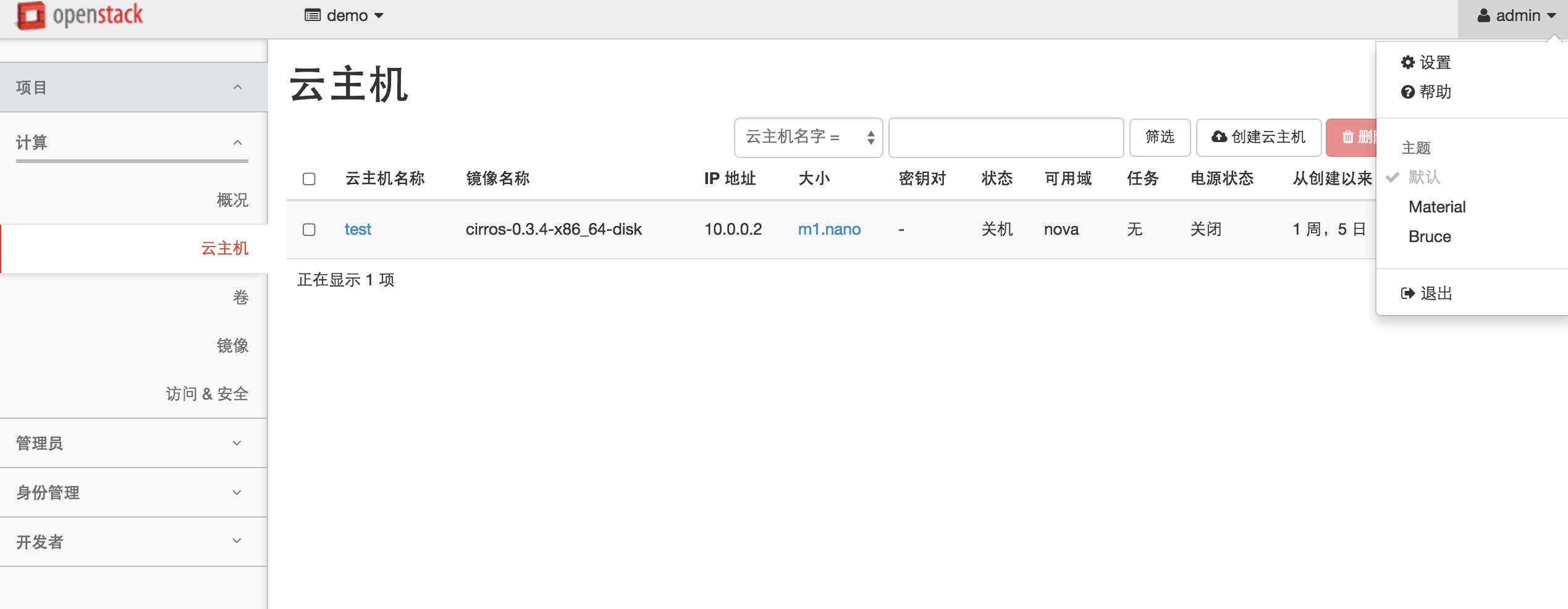
对原来主题没有任何影响,不得不佩服OpenStack Horizon代码架构越来越好了,
好了OpenStack Horizon的主题开发就讲到这里,基本上都说了一些,时间仓促,有错误望指出,谢谢!后续将推出更多这样的文章!
以上是关于OpenStack Mitaka Horiozn 主题开发的主要内容,如果未能解决你的问题,请参考以下文章